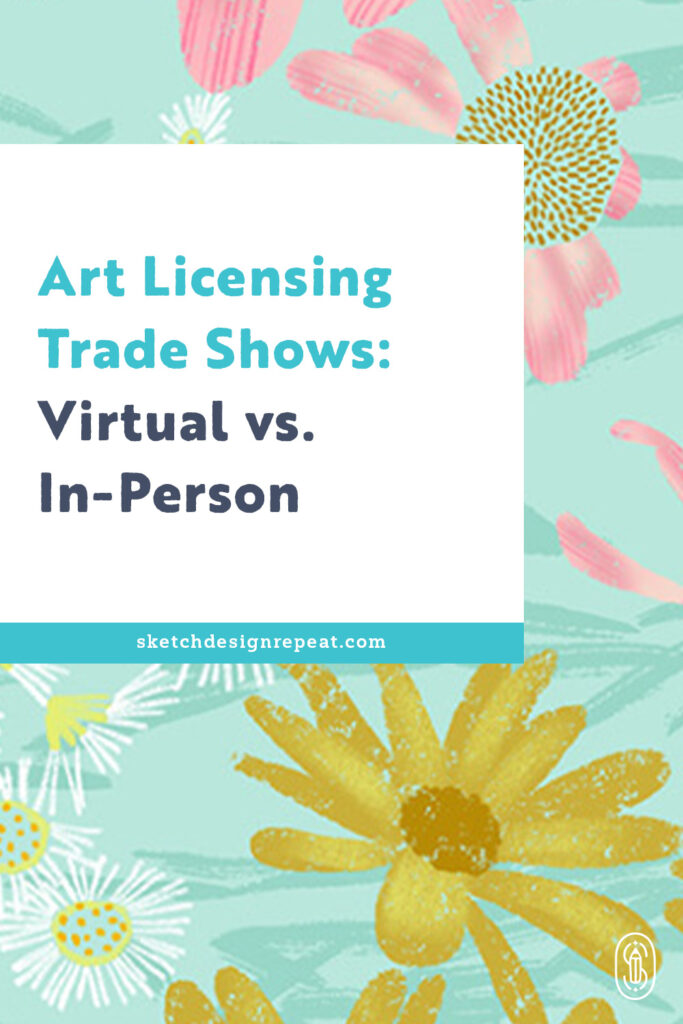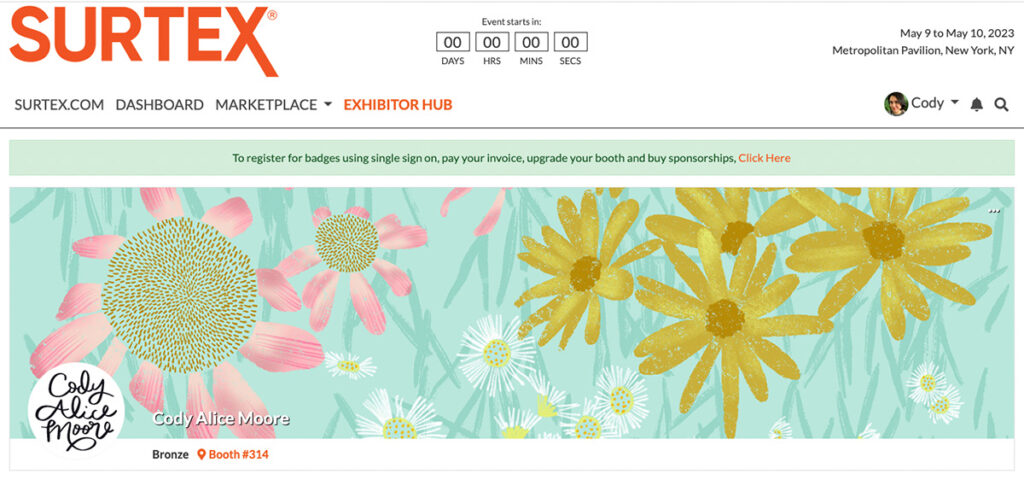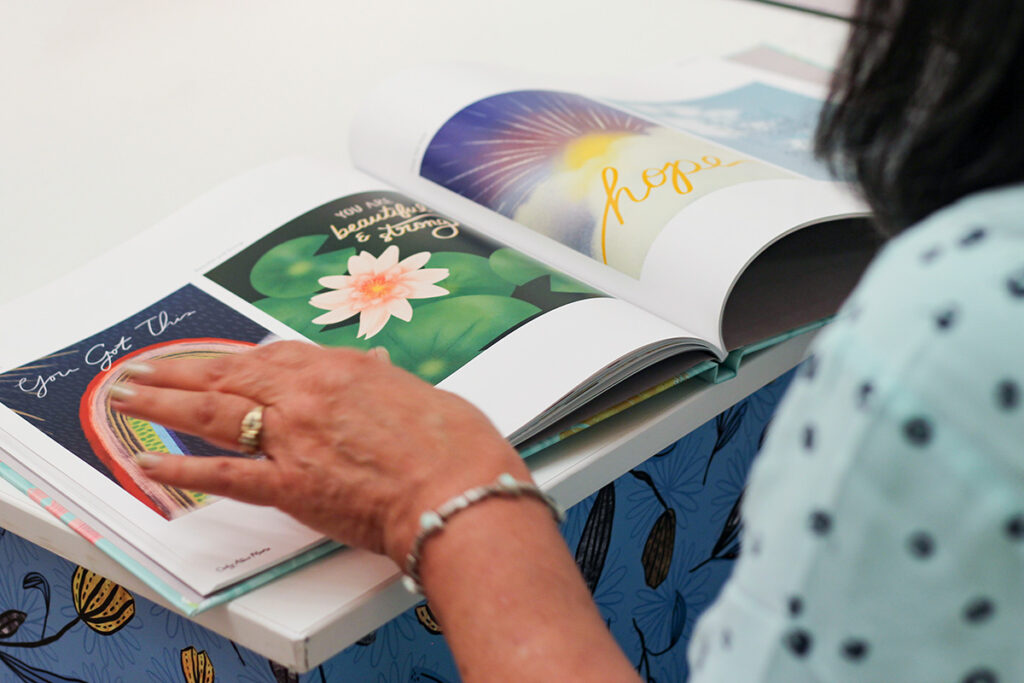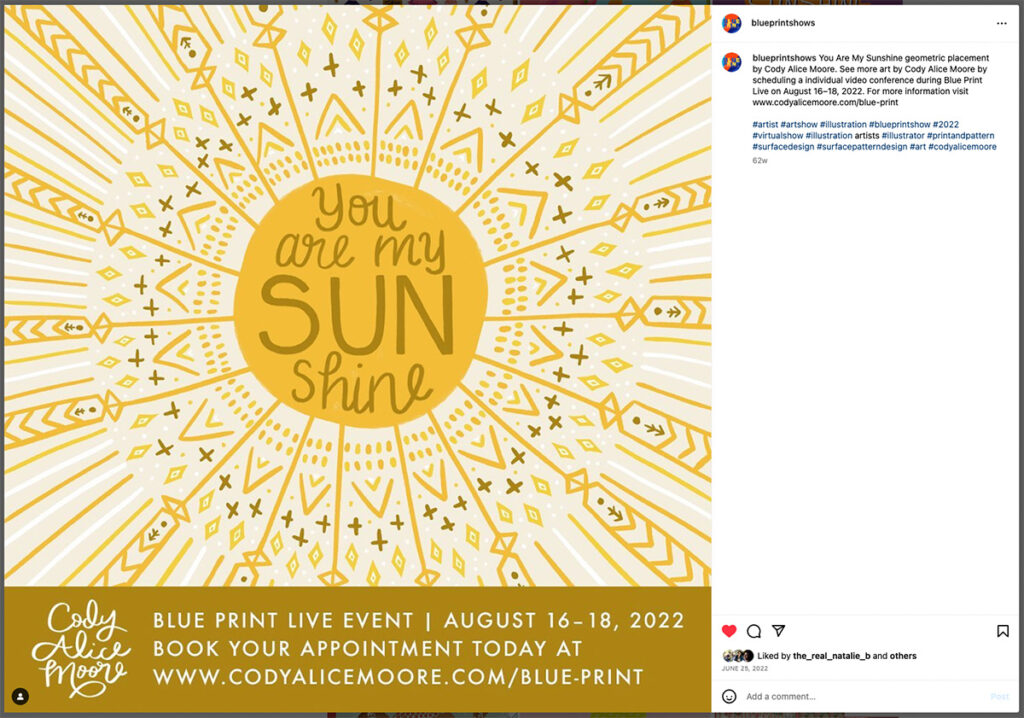As an active member of the surface pattern design industry for a year before the COVID-19 pandemic, I’ve witnessed the profound impact the pandemic had on our exhibition methods and connections with clients and peers.
Virtual exhibitions, once in their infancy, quickly became the norm, replacing the familiar in-person gatherings that facilitated essential face-time for deal-making and networking.
Now, as we gradually emerge from the pandemic, I’d like to explore the distinctions between virtual and in-person exhibitions, examine the challenges and benefits of each format, and consider how these changes are shaping the future of exhibiting in the surface pattern design industry.

The Differences Between Exhibiting Virtually vs. In-Person
The Physical vs. the Digital
A crucial distinction between virtual and in-person trade shows lies in the stark contrast between physical and digital experiences. In-person trade shows offer the unique advantage of face-to-face interactions with potential and existing clients.
As art directors stroll down the aisles of a trade show floor, they can decide in an instant whether the artwork in nearby booths aligns with their company’s needs, a spontaneous interaction that might not have occurred otherwise. This personal interaction streamlines the process, eliminating the initial time investment artists would have spent searching for the contact information of the right person at a company they want to work with.
On the contrary, virtual exhibitions rely on artists uploading their digital portfolios and bios, competing for attention among a multitude of artworks on the same webpage. The challenge here lies in standing out amid the digital crowd.
Networking and Relationship Building
In-person trade shows have long been celebrated as the ultimate networking playground. Chance encounters in hallways, serendipitous conversations over coffee, and shared meals all contribute to fostering a sense of community among exhibitors and attendees. Building relationships in this setting is typically easier and more enjoyable.
In contrast, virtual trade shows present a different set of challenges for networking. While platforms have incorporated chat rooms and made it easier to schedule video calls, the spontaneity of in-person interactions is often lost.
Establishing meaningful connections in the virtual realm requires more deliberate effort. However, there are ways to mitigate this. For example, both of the virtual trade shows I exhibited at in the past provided the names and contact information of attendees after the show ended, offering a valuable opportunity to reach out directly and pitch to companies during and after the show.
Related Class: Trade Show Success
Costs and Logistics
The costs of participating in trade shows can be a significant factor for designers and businesses. In-person shows have expenses such as booth rental, the printing and shipping of booth banners, marketing materials, travel, accommodation, meals, and transportation. For example, when I exhibited at Surtex in 2023, the cost exceeded $8,000.
On the other hand, virtual exhibitions often come with a reduced financial burden. While there are still fees associated with virtual booth space and marketing, they are significantly lower compared to the expenses of traditional in-person shows.
In my experience, exhibiting in two virtual shows in 2022 cost only 6% of what it did to exhibit in person at Surtex. Additionally, logistics become simpler when you don’t have to transport physical banners and booth assets, and set up a physical booth.

Challenges and Benefits of Virtual Trade Shows
Challenges of Virtual Trade Shows
- Virtual shows by nature aren’t as immersive as in-person events, resulting in less engagement. Attendees are more prone to distraction, making it challenging to hold their attention. I can relate to this as I attended trade shows in person when I was an art buyer. If I were to attend a virtual one, I’d likely find myself drawn back into my daily work tasks and overwhelmed by the volume of art on my computer screen. There’s something to be said about the tactile quality of looking at art printed out.
- Connectivity problems, glitches, or unfamiliarity with virtual platforms can affect the flow of virtual exhibitions for both exhibitors and attendees.
- As mentioned earlier, building relationships and networking can be more challenging in a virtual environment, requiring exhibitors to be more proactive in initiating conversations and connecting with potential clients.
Benefits of Virtual Trade Shows
- Virtual exhibitions offer accessibility to a global audience. It also eliminates the need for physical travel, reducing the financial burden of attendees. While in-person shows can have an international scope, they are typically located in specific cities or regions, requiring attendees to travel to those locations. Virtual exhibitions, on the other hand, are accessible to attendees from all over the world, resulting in a more diverse audience.
- The reduced costs of virtual trade shows make them an attractive option for emerging artists looking to showcase their work without spending a lot of money. I deliberately chose virtual exhibitions as a way to ease into the world of trade shows. It provided an excellent opportunity to gain experience in marketing and networking for such events.
- The convenience of virtual exhibitions allows attendees to explore at their own pace, which can be particularly beneficial for those with busy schedules or facing time zone differences.

Challenges and Benefits of In-Person Trade Shows
Challenges of In-Person Trade Shows
- There are more logistics and costs associated with in-person exhibitions, which can pose a significant challenge, especially for new artists or those with limited budgets. Additionally, post-pandemic travel restrictions and health concerns have added an extra layer of complexity.
- They may have a more limited audience due to the geographical nature of in-person events, potentially causing artists to miss out on global opportunities.
- Physical trade shows often involve the use of resources such as printed materials, electricity, and transportation, contributing to their environmental footprint and impact.
Benefits of In-Person Trade Shows
- In-person trade shows offer an immersive experience that can’t be replicated virtually. The face-to-face interactions leave a lasting impression on attendees and help re-establish connections with existing clients.
- Networking opportunities at in-person events allow for organic relationship-building that can lead to collaborations and partnerships. When I attended Surtex, it was a lot of fun to meet peers from across the world whom I had previously connected with online.
- It can enhance brand visibility and credibility, demonstrating your commitment and willingness to invest in showcasing your work. As an art buyer, I heard that exhibiting 3 times at Surtex was important for surface designers who were serious about their careers. While this may not be as rigid today, there is still value in demonstrating your dedication to the industry by exhibiting in person at least once.

Thoughts on the Future of Exhibiting in the Surface Pattern Design Industry
The surface pattern design industry, like many others, stands at a crossroads in the realm of trade shows. The COVID-19 pandemic forced us to adapt to virtual exhibitions, and the knowledge gained from this experience will undoubtedly shape the future of our industry.
When I participated in an in-person exhibition for the first time post-pandemic, I couldn’t help but notice that it was considerably smaller than previous events.
The organizers were already planning for the next year’s show, and one noteworthy change they mentioned for the next show was planning for an increase in educational content for both attendees and exhibitors. Workshops were also integrated into the first virtual trade show I participated in, and I found them to be highly beneficial.
As we look ahead, the surface pattern design industry is poised for remarkable transformations. Some exciting future possibilities might include hybrid events, combining both virtual and in-person exhibitions, whether through virtual educational sessions or exhibition options.
For example, the pandemic forced the trade show Adobe Max to go virtual in 2020. It then became a hybrid event in 2022. Hybrid events offer numerous advantages, including the ability to reach a broader audience, cost-effectiveness, and flexibility in how attendees and exhibitors participate.
Additionally, while in-person events have traditionally been celebrated for networking opportunities, virtual components can enhance networking by providing tools for targeted connections and follow-up interactions.
Related Article: My Journey to Surtex: From Art Buyer to Exhibitor
It would be fascinating to see a future where enhanced virtual engagement leads to more immersive virtual trade show experiences. Imagine attendees donning virtual reality headsets to explore digital showrooms.
Or perhaps augmented reality (AR) may play a role, enhancing how attendees interact with patterns and designs. Virtual booths could feature AR markers that, when scanned with a mobile device, reveal 3D models, animations, and additional information about how illustrations and patterns could be translated to products, enriching the virtual experience.
The future will likely see the emergence of highly personalized virtual networking platforms, leveraging artificial intelligence and data analytics to connect exhibitors and attendees based on their specific interests, making virtual networking feel as spontaneous and abundant as in-person encounters.
Hopefully, the emphasis on education and skill development will continue to grow. Workshops, masterclasses, and webinars will become a cornerstone of trade shows, empowering both emerging and seasoned designers with valuable insights and expertise.
Lastly, the industry may witness an increased emphasis on sustainability, with a focus on adopting more eco-friendly practices and reducing the environmental impact of both virtual and in-person trade shows. Hybrid events can play a pivotal role in achieving these sustainability goals by minimizing the need for physical resources and reducing carbon emissions associated with travel.
The transition from in-person to virtual trade shows during the pandemic has compelled surface pattern designers and businesses to adapt and innovate. Both formats have their unique challenges and benefits, and the future of exhibiting in our industry is poised to strike a balance between virtual and in-person experiences.
As we journey forward, it’s crucial to glean insights from the lessons learned during the pandemic, harness the potential of technology, and place a strong emphasis on sustainability.
The world of surface pattern design is known for its resilience and adaptability, and by embracing these changes, we can continue to create inspiring artwork that resonates with audiences worldwide. In this dynamic landscape, the artistry and innovation of surface pattern design will continue to flourish, captivating the imaginations of artists and clients alike regardless of format.

Written by Cody Alice Moore
Website: www.codyalicemoore.com
Instagram: @codyalicemoore
Class: Client Feedback Strategies for Creatives
Cody is an artist, illustrator, and surface pattern designer with over 15 years of experience. Cody discovered surface design while working for four years as an art buyer for a national photo lab. Since 2019, she has been creating art full-time for her budding portfolio and growing collection of licensed designs.